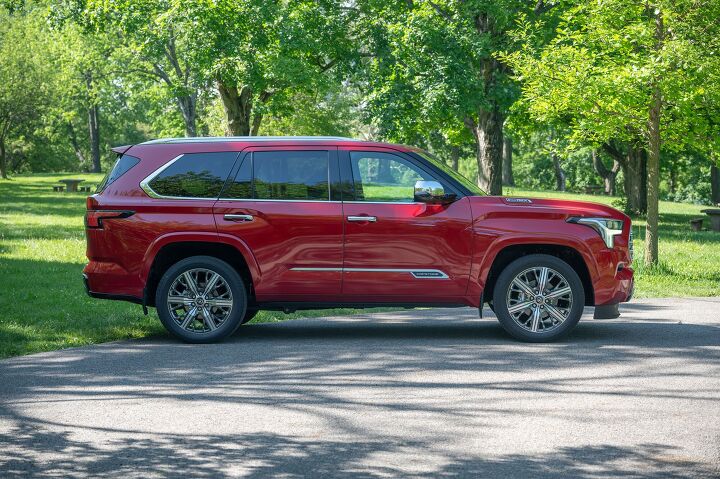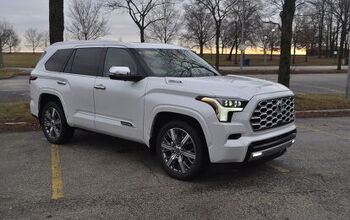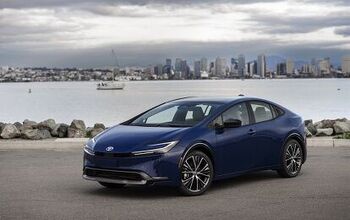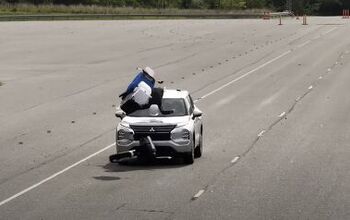2023 Toyota Sequoia Review - A Three-Row Prius?

2023 Toyota Sequoia Capstone 4WD
Toyota wasn’t the first to market a hybrid car here in the U.S. Despite that, the Prius has become the defining hybrid car of the past two decades or so, with the model name occasionally outshining the marque itself. Hybridization has metastasized throughout the Toyota lineup, punctuating nearly every model and segment with electrification.
It only stands to reason that the largest vehicles in a lineup, those vehicles for which fuel economy has never been the sole focus, should be among the last to see battery power. Within full-sized trucks and SUVs, however, there are plenty of gains to be made and plenty of room to stow extra batteries for additional economy and performance.
While the full-sized Tundra offers the choice between a standard turbo V-6 and hybridization, this 2023 Toyota Sequoia is hybrid only. How does it stack up in the real world? Is it a revelation in fuel efficiency, or does it keep you from seeing the redwood forest for the trees?
Whenever I drive a new vehicle, I try to look at it from a few angles. First, I ask myself where it might fit in my life and my driveway. But then I try and consider who the ideal buyer is, and ask how well it fits the needs of that buyer. Maybe it’s all the time I spent in sales, but I know that the marketing and planning departments always have that mythical target buyer in mind when they start to develop a new product.
Perhaps I’m a partial fit for the target demographic of the Sequoia, but I don’t specifically have a need for the size of this thing. When fitted with four-wheel drive, every trim level inches past the magical three-ton mark when empty. It’s 208.1 inches long and 79.6 inches wide, with a 122.0-inch wheelbase. I don’t tow anything regularly, but for those who do, the Sequoia can drag 8,980 pounds of boat, horse, car, or whatever.
For those who do need the capability of this big rig, it’s competitive. The 583 lb-ft of electrically-assisted torque is addictive. Sadly, dipping into the throttle does send the fuel economy reading south, as the 20 mpg combined estimate might be a bit optimistic. My time in the Sequoia yielded readings in the 17 mpg range. That’s no improvement upon what I typically experience in V8-powered domestic rivals. Maybe the big 22-inch wheels fitted to this top-level Capstone trim affect the economy somewhat, though there is no difference in the EPA ratings for lesser trims.
Comfort and ride quality aren’t what one might hope for out of a dreadnought-class SUV, either. Competitors have broadly moved to the independent rear suspension, but the Sequoia persists with the live rear axle borrowed from platform mate Tundra. Midcorner bumps send the hindquarters in a mild shimmy - it’s never uncontrollable, but it isn’t as plush a ride as one finds elsewhere.
The combination of a live axle and hybridization has another downside - rear headroom. The battery is above that axle, and thus right below the third-row seat. While this is a vehicle seemingly meant for hauling mass quantities of human cargo, those of average height and above will find themselves intimately acquainted with the texture of the headliner should they be unlucky enough to pull the short straw boarding position. Materials throughout the interior are quite nice, but that rear row is just a bit too cozy.
My concern with Toyota is they don’t seem to want to be the best with their mainstream vehicles - and that I’m talking about an eighty-thousand-dollar full-size luxury SUV as a mainstream vehicle is frankly absurd, to be honest. It feels as if Toyota is content to let their legendary customer loyalty and fabled reliability continue to feed customers into their showrooms, rather than building fully-realized market-leading vehicles. We know that Toyota has enthusiasts squirreled away within the engineering and product planning teams - witness the crazy GR Corolla I reviewed last month - but it often feels they deliberately hold back on their volume models.
The 2023 Toyota Sequoia is, frankly, more of the same. I have no doubts that they’ll easily sell every one they make. But competitors are building SUVs with fewer compromises, and that’s why I’m disappointed with Toyota’s biggest tree.
[Images: © 2023 Chris Tonn/TTAC.com]
Become a TTAC insider. Get the latest news, features, TTAC takes, and everything else that gets to the truth about cars first by subscribing to our newsletter.

Some enthusiasts say they were born with gasoline in their veins. Chris Tonn, on the other hand, had rust flakes in his eyes nearly since birth. Living in salty Ohio and being hopelessly addicted to vintage British and Japanese steel will do that to you. His work has appeared in eBay Motors, Hagerty, The Truth About Cars, Reader's Digest, AutoGuide, Family Handyman, and Jalopnik. He is a member of the Midwest Automotive Media Association, and he's currently looking for the safety glasses he just set down somewhere.
More by Chris Tonn
Latest Car Reviews
Read moreLatest Product Reviews
Read moreRecent Comments
- Zerofoo Farley's blunder here is that the "Tesla and Apple people" are not a large enough market to support all the car companies that want to sell EVs. Chinese manufacturers alone could meet the demand of that market entirely without western companies at all.Farley's must accept that many people don't want an EV at ANY price. EVs, even with advanced battery chemistries, still require long charging times and when the battery is dead there is an unavoidable charging interval before you can get going again.Liquid fueled cars simply do not have these limitations, are readily available and affordable, and have vast aftermarket parts and maintenance support. This mix of convenience and support may never exist for EVs.If I could run my mobile phone and laptop on liquid fuels I probably would. Battery power, in many products, feels like a step backward.
- Theflyersfan I'm in the camp of that not all speed kills, but extreme speed differential kills. On a long drive, I can fall into a groove with long haul traffic going 75-80 in a 70 to 75 mph zone. No driving crazy or dangerous. What causes many wrecks in those situations are those going 50 in the left lane (way too common here), scared mergers entering at 40 mph, semis blocking multiple lanes, and unsafe drivers not using lights or driving unsafe cars. I also think the rise of 500 hp, 6,000 pound SUVs have dulled people into not realizing how quickly they are moving. It's almost like cruising at 38,000 feet if the SUV is comfortable. 85 mph in that is nothing until sudden braking or swerving is needed. Then Newton's laws take over. Compare that to a 2,300 lb MX-5 a few inches off of the ground. When you go 80, you know it. The engine and noise remind you! And you respect the speed a bit more.So I'm against speed limiters. I'm for much stronger enforcement and education and graduated licensing.
- Srd275 Enough of the nanny state
- 28-Cars-Later I realize it would be rewarding failure but could we force the legislatures and Congress critters to only work for six months out of the year to limit the damage and overall level of stupidity released?
- Dartman In the heads up display of my BMW it displays the speed limit of the road I’m on and if I exceed it it shows my current speed in red. Not obtrusive at all and useful. Not hard at all to ignore like on the freeway where the average speed is 75 but the limit is 65. Much ado about nothing . Speed limiters would be a different matter.











































Comments
Join the conversation
Jumping in here to address the comments about 'the Sequoia persists with the live rear axle borrowed from platform mate Tundra'. Previous gen Sequoia actually went IRS for the 2008 MY straight through to 2022 MY.
I suspect they saw Ford go IRS in the Expedition in 2003 or 2004 and were quick to copy them. Then they saw GM stay with solid axle (and dominate the market) for another decade and decide it wasn't worth the added cost / complexity. Of course GM just went IRS, a couple of years ago, so we will have to wait another 15 year Sequoia product cycle to see if Toyota follows suit :)!
80K for a Toyota that is not named Land Cruiser...